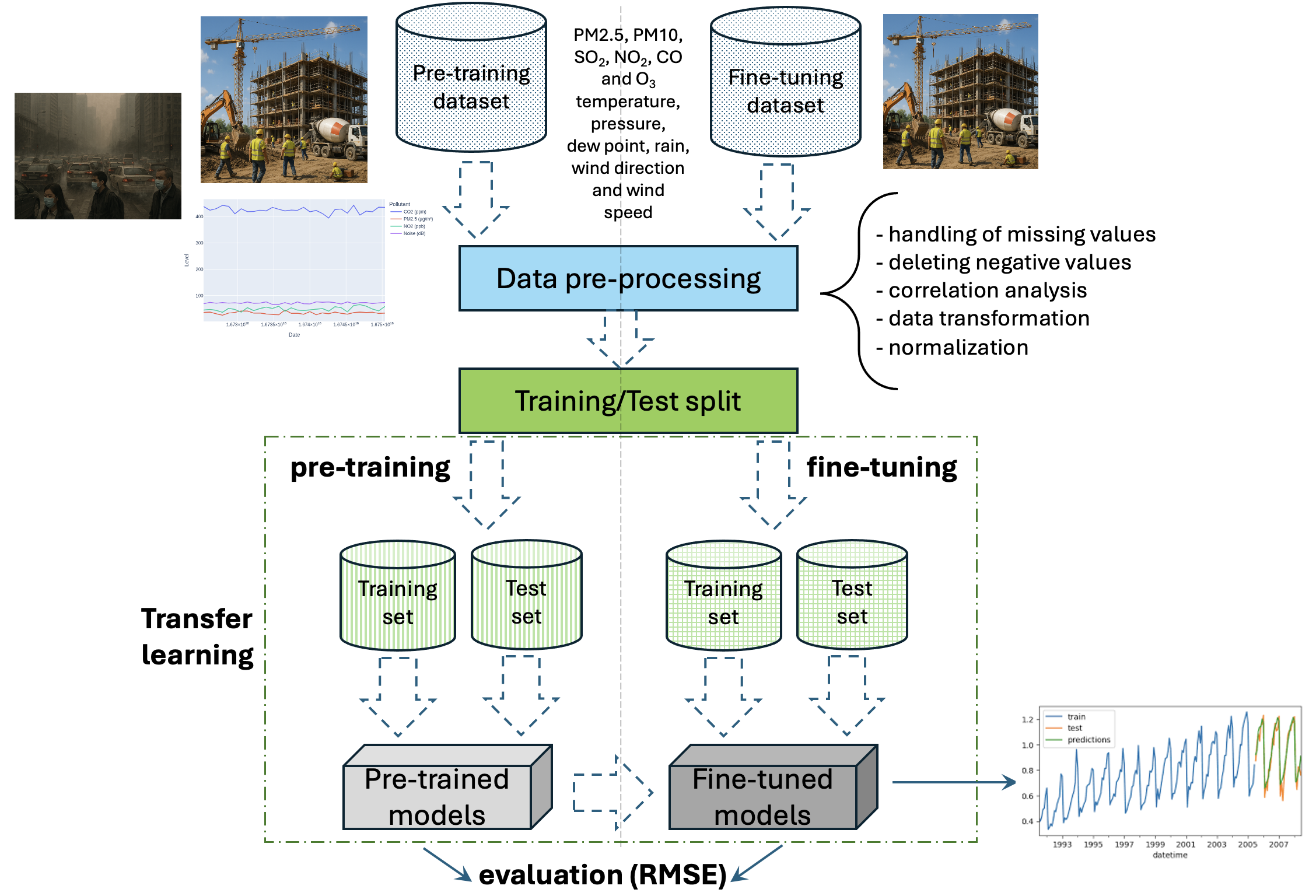by Eliezer Zahid Gill, Daniela Cardone, Alessia Amelio (Department InGeo, University "G. d'Annunzio" Chieti-Pescara, Italy)
The study introduces a new framework using transfer learning with deep neural networks for reliably forecasting multiple air pollutants and is designed for use at construction sites. The framework outperforms other related approaches, enhancing environmental monitoring and promoting sustainability.
Construction site activities are a major contributor to urban pollution, posing a serious threat to the environment and endangering the health of workers and nearby residents. Indeed, the various steps of a construction project, from demolition to building, generate different types of air pollutants, including suspended particulate matter (PM), carbon monoxide (CO), nitrogen dioxide (NO2), ozone (O3) and sulphur dioxide (SO2). Among the air pollutants, PM2.5 and PM10, mainly caused by construction vehicles, are particularly dangerous, and multiple studies have proved their impact on the global annual mortality, and correlation with different illnesses, such as respiratory and cardiovascular diseases, infertility, damage to the nervous system and cancer. Accordingly, the identification and monitoring of the air pollution at construction sites is very important for guaranteeing healthy workplaces and lessening the environmental effect and for adopting adequate policies and preventive measures that aim for sustainability. In this regard, regulatory references and limits imposed for the control of air pollution have been introduced, e.g. Directives 2008/50/EC, 2004/107/EC, and 2004/37/EC, as well as real-time monitoring systems of the air quality. However, these methods are not capable of forecasting the diffusion of air pollutants at the construction sites, hence, they do not avoid the exposure of workers and inhabitants to the air pollutants.
In the last years, different Artificial Intelligence (AI) methods started flourishing in the literature with the aim to forecast the diffusion of air pollutants at construction sites equipped with sensor networks monitoring meteorological and environmental variables [1]. Artificial Neural Network (ANN) models were employed to forecast the concentrations of dust emissions from temperature, humidity, and velocity of the wind, to predict the hourly CO2 emissions and energy consumption of multiple types of Caterpillar excavators in various earthwork conditions, and to estimate the diffusion coefficient of CO2 in concrete structures from input variables like cement content, water-cement ratio, volume of the aggregate, and relative humidity. ANN, regression tree, random forest, and linear regression models were used to predict emission levels of CO, NOx, CO2, SO2, and CH4, from heavy construction machinery. Other AI models were created to predict the environmental implications of construction materials. The main drawback of the proposed approaches is that they focus on particulate matter or gaseous pollutants. Furthermore, most of them are capable of providing a forecast of only a few hours, limiting the requirements of proactive management of the construction sites. Finally, they need a large dataset for training the model from scratch when it is adopted in different construction environments.
To overcome these limitations, we proposed a new deep learning framework based on transfer LSTM (Long Short-Term Memory) networks to forecast the temporal diffusion of six matter and gaseous pollutants (PM2.5, PM10, SO2, NO2, CO and O3) at a given location of the construction site 12-hours in advance based on the past two days of data [2, 3] (see Figure 1). An LSTM network is a type of ANN that helps predict future values based on past data. It acts like a memory system that learns patterns over time. The network remembers important trends and forgets less useful details using special gates, which are small neural network layers. This makes it very useful for handling time-based pollution data where the order and timing of values matter.

Figure 1: Schema of the new deep learning framework based on transfer LSTM networks.
The input of the framework included a previous batch of time-dependent air pollutants' concentrations, and meteorological variables (temperature, pressure, dew point, rain, wind direction and wind speed). The proposed framework was composed of the following steps: (i) data pre-processing, (ii) training of the LSTM model, and (iii) testing of the LSTM model. Data pre-processing included typical tasks, like handling of missing values, deleting negative values, correlation analysis, and data transformation and normalization. Transfer learning was employed for training the LSTM model and included a pre-training phase and a fine-tuning phase. In the former phase, the model could be pre-trained with a larger dataset from a similar domain, with synthetic data or with data acquired from a different sensor station in the construction site. In the latter phase, training of the model was refined with data acquired from the specific construction site at the given location, to reliably predict the pollutants at that location. Transfer learning allows one to easily use the model in different construction site contexts, as it only needs a smaller dataset to set up the model for the specific context. Finally, testing of the model aimed to evaluate the model’s performances of both pre-training and fine-tuning phases by computing typical performance measures, like the Root Mean Squared Error (RMSE), on the test data (lower values mean better forecast performances).
The study evaluated model performances on different meteorological and environmental datasets using RMSE. It found that LSTMs achieved lower RMSE than many other competing models, like random forests and ANNs, proving more reliable for forecasting air quality at construction sites.
The work is taking place at the High Performance Computing Laboratory of the Department of Engineering and Geology, University “G. d’Annunzio” Chieti-Pescara, Italy. The institutes that have collaborated in this work are the Institute for Bioeconomy of the National Research Council of Italy, Tea Group S.r.l. and Italferr S.p.A. of the Italian State Railways. Future work will include the model deployment to make it available for use via an API or web application.
References:
[1] E. Z. Gill, D. Cardone, A. Amelio, “Revolutionizing the construction industry by cutting edge artificial intelligence approaches: a review,” Front. Artif. Intell., vol. 7, 2024.
[2] M. Mastromatteo and A. Amelio, “A Deep Learning Approach for Predicting Air Pollutants on the Construction Site,” MIPRO 2024, pp. 2089-2094, IEEE.
[3] E. Z. Gill, D. Cardone, A. Amelio et al., “Integrating Meteorological Data with Artificial Intelligence for Air Quality Prediction on Construction Sites,” INFOTEH 2025, pp. 1-6, IEEE.
Please contact:
Alessia Amelio
Department InGeo, University “G. d’Annunzio” Chieti-Pescara, Italy










